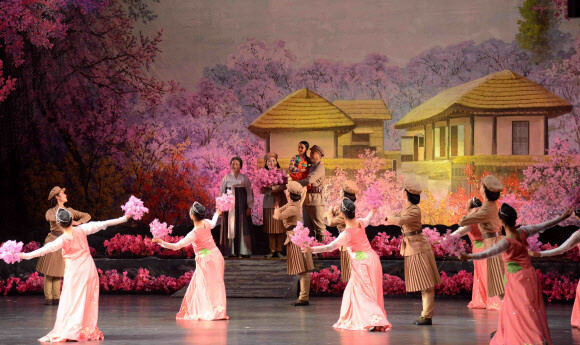hankyoreh
Links to other country sites 다른 나라 사이트 링크
North Korea proposes that Samjiyon musical group cross into South Korea via Panmunjeom

Interest is focusing on North Korea’s proposal for the musical group that will be performing during the Pyeongchang Winter Olympics to cross into South Korea overland at Panmunjeom. Considering that it is highly unusual for such a large group – more than 140 members in this case – to cross the border at Panmunjeom, experts are offering various interpretations of Pyongyang’s intentions.
During the working-level inter-Korean talks held on Jan. 15 to arrange a visit by the North Korean musical group, the North announced that it intended for the Samjiyon members to travel overland via Panmunjeom to Seoul and Pyeongchang and asked South Korea for help with transportation. The South Korean government is reportedly planning to make its final decision about an overland visit to the South following deliberations with the UN Command, which has jurisdiction over the military demarcation line.
Generally speaking, there are three ways to travel by land between North and South Korea. There are two inter-Korean transit offices that opened in Jan. 2006, one on the Gyeongui Line, servicing the Kaesong Industrial Complex, and one on the East Sea line, supporting tours to Mount Kumgang. Finally, there is the direct route through Panmunjeom. Traveling between North and South Korea overland, instead of by plane or ship, inevitably means crossing the military demarcation line. This in turn requires getting permission from the UN Command, which has jurisdiction over the line.
It’s not completely unprecedented for such a large group to cross the border at Panmunjeom. In Sept. 1985, two groups of 151 people, one from the North and the other from the South, visited Seoul and Pyongyang via Panmunjeom. The groups consisted of artists, as well as people separated from their family members during the Korean War who were visiting their old homes. Chung Ju-yung, founder of the Hyundai Group, crossed into North Korea at Panmunjeom on two occasions – in June and Oct. 1998 – with trucks carrying 1,001 head of cattle.
During past examples of inter-Korean exchange and travel, it has been South Korea that preferred overland transportation. The reason is that simply allowing people to cross the military demarcation line symbolizes the relaxing of tensions between North and South Korea. But North Korea has for the most part been reluctant to allow this, because of the road conditions and other transportation concerns.
“North Korea’s proposal to cross overland at Panmunjeom is probably connected to its motivations for participating in the Pyeongchang Winter Olympics,” said Kim Yeon-cheol, a professor at Inje University. The professor speculated that North Korean leader Kim Jong-un chose the passage at Panmunjeom as a symbolic means of creating a mood for peace and relaxing the crisis on the Korean Peninsula around the Pyeongchang Olympics, as he said during his New Year’s address.
“There’s a crossing on the Gyeongui Line, but that’s not feasible since the Kaesong Industrial Complex is closed, and the same is true of the East Sea Line [because tours to Mount Kumgang are halted]. For the moment, the overland route via Panmunjeom is probably the most convenient form of transportation,” said Koo Kab-woo, a professor at the University of North Korean Studies.
“If North Korea has proposed crossing into South Korea via the inter-Korean transit office on the Gyeongui Line, it might have come across as pressure to reopen the Kaesong Industrial Complex,” said Cho Seong-ryeol, chief of research for the Institute for National Security Strategy.
By Jung In-hwan and Kim Ji-eun, staff reporters
Please direct questions or comments to [english@hani.co.kr]

Editorial・opinion
![[Guest essay] The real reason Korea’s new right wants to dub Rhee a founding father [Guest essay] The real reason Korea’s new right wants to dub Rhee a founding father](https://flexible.img.hani.co.kr/flexible/normal/500/300/imgdb/original/2024/0423/8317138574257878.jpg) [Guest essay] The real reason Korea’s new right wants to dub Rhee a founding father
[Guest essay] The real reason Korea’s new right wants to dub Rhee a founding father![[Column] ‘Choson’: Is it time we start referring to N. Korea in its own terms? [Column] ‘Choson’: Is it time we start referring to N. Korea in its own terms?](https://flexible.img.hani.co.kr/flexible/normal/500/300/imgdb/original/2024/0423/3617138579390322.jpg) [Column] ‘Choson’: Is it time we start referring to N. Korea in its own terms?
[Column] ‘Choson’: Is it time we start referring to N. Korea in its own terms?- [Editorial] Japan’s rewriting of history with Korea has gone too far
- [Column] The president’s questionable capacity for dialogue
- [Column] Are chaebol firms just pizza pies for families to divvy up as they please?
- [Column] Has Korea, too, crossed the Rubicon on China?
- [Correspondent’s column] In Japan’s alliance with US, echoes of its past alliances with UK
- [Editorial] Does Yoon think the Korean public is wrong?
- [Editorial] As it bolsters its alliance with US, Japan must be accountable for past
- [Guest essay] Amending the Constitution is Yoon’s key to leaving office in public’s good graces
Most viewed articles
- 1[Guest essay] The real reason Korea’s new right wants to dub Rhee a founding father
- 2Terry Anderson, AP reporter who informed world of massacre in Gwangju, dies at 76
- 3[Column] ‘Choson’: Is it time we start referring to N. Korea in its own terms?
- 4Why Korea shouldn’t welcome Japan’s newly beefed up defense cooperation with US
- 5Opposition calls Yoon’s chief of staff appointment a ‘slap in the face’
- 6[Column] The clock is ticking for Korea’s first lady
- 7Senior doctors cut hours, prepare to resign as government refuses to scrap medical reform plan
- 8New AI-based translation tools make their way into everyday life in Korea
- 9[Editorial] Japan’s rewriting of history with Korea has gone too far
- 10[Column] Are chaebol firms just pizza pies for families to divvy up as they please?